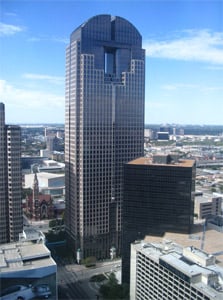This may be old news, but as far as history goes, a lot of us forget it.
And you know what happens then - we're doomed to repeat it.
What I like about people forgetting history are the trading and investing opportunities that pop up when I can see the past coming back to haunt us before others do.
So, today I'm going to share the latest twist on some old news. If you want to make some money on it, stay tuned.
 I'll show you what I'm going to do, and I'll let you know when I start doing it...
I'll show you what I'm going to do, and I'll let you know when I start doing it...
Bear Hunting
Here's the history you may have forgotten.
The Too Big to Fail (TBTF) banks were all going strong in 2007. Then, in 2008, all of a sudden they weren't.
In 2007, Bear Stearns was the seventh-largest global investment bank and securities trading company in the world. In July 2007, two of its hedge funds began having lots of trouble and ended up sinking like stones in the vast mortgage-pool black hole they were betting heavily on.
While a lot of people think that was the beginning of the end for Bear, it didn't have to be.
Fast-forward to March 14, 2008. Bear Stearns was, by most accounts and legitimate accounting methods, totally insolvent. But the U.S. Federal Reserve agreed on that day to provide Bear a 28-day, $25 billion loan to get its act together.
The very next day the folks at the New York Fed said, "Never mind, we're not helping you." And one day after that, the New York Fed essentially funded with $29 billion JPMorgan Chase & Co. (NYSE: JPM)'s $2 a share buyout of Bear. For its part, JPM put up a whopping $1 billion and got all kinds of protection against any losses.
As far as TBTF goes, Bear's stock was trading at $172 in January 2007 and at $93 in February 2008.
And a month later, JPMorgan Chase pays $2/share to buy all of Bear's assets?
To be fair, a subsequent class-action suit forced JPM to raise its price to $10/share. Not out of generosity, but to minimize shareholder suits in the future.
The Second Victim
Fast-forward again to the fall of 2008, and like déjà vu all over again, Lehman Brothers followed Bear Stearns into the toilet. Only this time nobody was there to pick it up.
The fourth-largest investment bank in the United States died an ugly death.
The Lehman story is even more interesting than the Bear story. But this isn't about stories.
The truth is that both Bear and Lehman were systematically exterminated.
They were both gang-tackled (I'd like to use another phrase here, but my publisher won't let me) by their competitors to eliminate them from the shark tank that was getting crowded by them getting too big to compete easily against.
Who led this band of murderers? Goldman Sachs Group Inc. (NYSE: GS), of course.
There's so much information out in the public domain that there's no refuting it. The only thing that isn't out there is a book that brings all the pieces together and tells the whole truth.
Former Goldman men were running the New York Federal Reserve and the U.S. Treasury. And a former Goldman man was guiding JPMorgan Chase's backroom deals.
Now, Goldman is at it again...
Two Down...
This time Goldman is going after JPMorgan Chase (NYSE: JPM). Its old partner in crime has become too big to compete against, and Goldman wants JPM dismantled.
JPMorgan Chase is too big and too strong to kill. So Goldman has jumped on a bandwagon of analysts who, for about a month now, have been suggesting JPMorgan would be a better deal for shareholders if it was broken up.
Goldman being Goldman, it waited for a couple of others to start singing the breakup song before it raised its voice above theirs. About a month ago, highly respected CLSA bank analyst Mike Mayo came out in a client report calling for JPMorgan Chase to be broken up to rid itself of the "conglomerate discount" its stock price is suffering from.
Then a Wells Fargo & Co. (NYSE: WFC) analyst said JPM might need as much as $45 billion a year in new capital, for several years, to meet the new "capital surcharge" rules all the big banks are facing.
But it was Goldman bank analyst Richard Ramsden who caught the most attention when he said last week that it's time to break up JPMorgan Chase.
I'm not saying it's time to short JPMorgan Chase because it's now in trouble like Bear and Lehman were back in the late 2000s. JPM is not in trouble.
But JPM is trouble for Goldman.
Goldman bought credit default swaps on Bear and Lehman and shorted their stocks mercilessly. Goldman drove them into insolvency and out of business.
Two down and two to go.
Now we know Goldman wants to take out JPM, and no doubt GS will eventually attack Morgan Stanley (NYSE: MS).
That's going to be a rumble in the jungle, and it's going to be fun to watch.
Goldman Sachs is simply the best at what it does. Everything it does - good and evil.
I'm going to watch how Goldman's new trade setup pans out. Because it's a trade, you know.
It's about Goldman Sachs making money while eliminating a competitor. That's how it trades.
I'll figure out the timing and how we can join in. And then I'll show you how we're going to play it.
More from Shah Gilani: Media has it that third-quarter gross domestic product (GDP) number showed the U.S. economy grew at a whopping rate of 5%! Way to go us, right? This is great news, isn't it? Nope. It's all BS. Here's why...
About the Author
Shah Gilani boasts a financial pedigree unlike any other. He ran his first hedge fund in 1982 from his seat on the floor of the Chicago Board of Options Exchange. When options on the Standard & Poor's 100 began trading on March 11, 1983, Shah worked in "the pit" as a market maker.
The work he did laid the foundation for what would later become the VIX - to this day one of the most widely used indicators worldwide. After leaving Chicago to run the futures and options division of the British banking giant Lloyd's TSB, Shah moved up to Roosevelt & Cross Inc., an old-line New York boutique firm. There he originated and ran a packaged fixed-income trading desk, and established that company's "listed" and OTC trading desks.
Shah founded a second hedge fund in 1999, which he ran until 2003.
Shah's vast network of contacts includes the biggest players on Wall Street and in international finance. These contacts give him the real story - when others only get what the investment banks want them to see.
Today, as editor of Hyperdrive Portfolio, Shah presents his legion of subscribers with massive profit opportunities that result from paradigm shifts in the way we work, play, and live.
Shah is a frequent guest on CNBC, Forbes, and MarketWatch, and you can catch him every week on Fox Business's Varney & Co.



